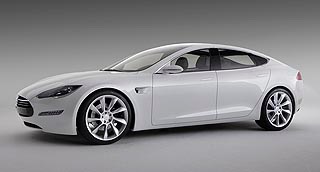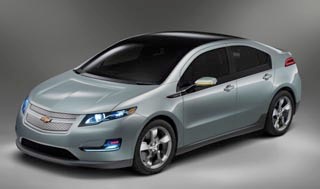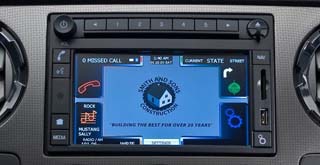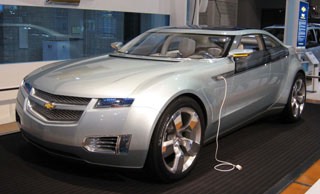
Not all plug-in hybrids have to be boring econoboxes or family sedans. The all-wheel drive Porshce 918 Spyder utilizes the near instantaneous torque of its two electric motors to provide boost support to its 608 HP 4.6-L V8 combustion engine to post record lap times at the track. In September 2012, a Porsche 918 Spyder prototype posted a lap time of 7:14 minutes on the North Loop of the Nürburgring- this was 20 seconds faster than a Porsche Carrera GT.
As expected the Porsche 918 Spyder is equipped with all manner of race-inpired and state-of-the-art technologies. The entire load-bearing structure is made of carbon fiber reinforced polymer for low-weight and torsional rigidity, and the multi-link chassis includes an adaptive shock-absorber system and speed sensitive rear-axle steering to improve cornering and stability. Also included is Porsche Active Aerodynamic (PAA), a system of adjustable aerodynamic elements that utilizes a retractable and adjustable rear wing, extendable spoilers, adjustable air flaps, and adjustable air inlets to improve high-speed driving dynamics and maximize fuel efficiency.
The driver can select from one of five operating modes via a “map switch" on the steering wheel. They range from "E-Power," in which the car can reportedly drive for 18 miles on electric power only, to "Hot Lap" which pushes the traction battery to its maximum power output for a few fast laps and maybe a new record.
Another vehicle in development worth watching is the Tesla Model S. With styling on par with designs like the Fisker Karma and  conventionally powered four-door cars from Maserati and Porsche, this all electric vehicle is scheduled for production in 2012. The starting price is $57,400, before the promised $7,500 federal tax credit. That brings the final cost to just below $50,000. Features of the car include seating for five adults plus room for an additional two children's car seats in the back, flat folding rear seats, charge ranges from 160 to 300 miles (depending on model chosen), and the ability to charge the vehicle on everything from standard 120V household current to a 480v dedicated system.
conventionally powered four-door cars from Maserati and Porsche, this all electric vehicle is scheduled for production in 2012. The starting price is $57,400, before the promised $7,500 federal tax credit. That brings the final cost to just below $50,000. Features of the car include seating for five adults plus room for an additional two children's car seats in the back, flat folding rear seats, charge ranges from 160 to 300 miles (depending on model chosen), and the ability to charge the vehicle on everything from standard 120V household current to a 480v dedicated system.
A charge range of 160 miles would be acceptable to many buyers, especially in a car that looks this good. However, it is not far enough for anyone requiring a car to take on extended vacations, which seating for up to seven (including young children) would imply. Ranges can be increased, but the price point will increase as well. This means all versions of the "S" will most likely appeal to a very narrow market, as does the current Tesal Roadster costing more than $100,000.
Something happened on the way to production. Unveiled in September 2008, the production version of the Chevrolet Volt has lost much of  its cutting edge style and visual appeal in the name of decreasing drag and improving fuel economy. It also lost seating capacity, down from five to four, but gained in price, now estimated to be near $40,000 (or $35,000, as GM has kept pricing a guarded secret even as production nears). This begs the question, "who will buy it?" While the Volt still possesses a revolutionary propulsion system, and one that could change the way we view automobiles for some time, the price point may place the Volt in the position of a cachet vehicle rather than a vehicle for the masses as originally envisioned. At $4 a gallon gasoline it would take the average driver more than six years to recover the cost difference between a 30 mpg economy car costing $30,000 (of course, there are economy cars costing thousands less), and the $40,000 Volt- even if the Volt driver never burned a single gallon of gas. Promised tax incentives would certainly change this calculation, as would continued lower fuel costs. More likely, as competition for alternative fueled and operated vehicles continues to increase, functionality, operator ease, maintenance and reliability, and styling will likely play a bigger role in consumer decision making in the category.
its cutting edge style and visual appeal in the name of decreasing drag and improving fuel economy. It also lost seating capacity, down from five to four, but gained in price, now estimated to be near $40,000 (or $35,000, as GM has kept pricing a guarded secret even as production nears). This begs the question, "who will buy it?" While the Volt still possesses a revolutionary propulsion system, and one that could change the way we view automobiles for some time, the price point may place the Volt in the position of a cachet vehicle rather than a vehicle for the masses as originally envisioned. At $4 a gallon gasoline it would take the average driver more than six years to recover the cost difference between a 30 mpg economy car costing $30,000 (of course, there are economy cars costing thousands less), and the $40,000 Volt- even if the Volt driver never burned a single gallon of gas. Promised tax incentives would certainly change this calculation, as would continued lower fuel costs. More likely, as competition for alternative fueled and operated vehicles continues to increase, functionality, operator ease, maintenance and reliability, and styling will likely play a bigger role in consumer decision making in the category.
It's hard to judge GM too harshly on the price increases, as they are dealing with new technologies. And production is still planned for late 2010. But the prototype's styling certainly was pushed by GM in the press and at auto shows, and may have created more interest in the car than it deserved. It is recognized that aerodynamics are important to overall fuel economy, especially as speed increases. But there is no denying that to make such a radical change to a "safe" design is disappointing, and certainly lessens the appeal of the car to many potential buyers. And due to its design similarity to other hybrids, the Volt becomes just one of several competing models.
The link is the same as the one used for the original article on the Volt found at the bottom of this page. Both point to GM's website.
Ford has teamed up with DeWalt, Garmin, Magneti Marelli, Master Lock, and Sprint to create a technological toolset for their worktrucks. A n onboard computer is teamed with RFID technology, GPS, and mobile communications to expand on the idea of a worktruck acting as mobile office for the construction oriented worker or manager. Besides that the old Italian racing supplier marque Magneti Marelli is involved (I used to put their stickers on my slot cars), the most interesting feature is the use of RFID technology to keep track of tools in the truck. In addition to letting the driver know if a tool is missing, the system can be programmed for specific tool lists for a particular type of job and used to make sure all required tools are loaded before leaving the shop or office. The Crew Chief feature uses GPS technology to track errant workers on an extended coffee break, or route them to the nearest job site, much like current GPS systems operated from a dispatch office. Master Lock provides a cable locking system that can be run through tool handles and other openings to secure what's loaded from theft. A monthly fee is required to access all features, and no doubt the proprietary technology will help build brand loyalty for Ford. A similar, though not as technologically capable, system was introduced by GMC as a concept in 1999.
n onboard computer is teamed with RFID technology, GPS, and mobile communications to expand on the idea of a worktruck acting as mobile office for the construction oriented worker or manager. Besides that the old Italian racing supplier marque Magneti Marelli is involved (I used to put their stickers on my slot cars), the most interesting feature is the use of RFID technology to keep track of tools in the truck. In addition to letting the driver know if a tool is missing, the system can be programmed for specific tool lists for a particular type of job and used to make sure all required tools are loaded before leaving the shop or office. The Crew Chief feature uses GPS technology to track errant workers on an extended coffee break, or route them to the nearest job site, much like current GPS systems operated from a dispatch office. Master Lock provides a cable locking system that can be run through tool handles and other openings to secure what's loaded from theft. A monthly fee is required to access all features, and no doubt the proprietary technology will help build brand loyalty for Ford. A similar, though not as technologically capable, system was introduced by GMC as a concept in 1999.
Read my piece published January 9th, 2007, in the Daily Oklahoman regarding the recent Energy Bill.
GM has come up with an intriguing variation of the hybrid vehicle concept with the Chevrolet Volt. Hybrids currently in production, such a s the Toyota Prius or Ford Escape Hybrid, utilize an electric motor in combination with an internal combustion engine to drive the wheels. In these configurations the electric motor is primarily used to get the vehicle going from a start, or at low speeds, with the internal combustion engine becoming the primary source of power at all other times. What sets the Volt concept apart is the electric motor is the only source of power connected to the wheels, with the internal combustion engine used as a generator to recharge the onboard batteries when needed. This configuration allows the internal combustion engine to run at a constant and most efficient speed. It also allows the use of any conventional or alternative fuel in the engine, or the use of a hydrogen fuel-cell to generate electricity.
s the Toyota Prius or Ford Escape Hybrid, utilize an electric motor in combination with an internal combustion engine to drive the wheels. In these configurations the electric motor is primarily used to get the vehicle going from a start, or at low speeds, with the internal combustion engine becoming the primary source of power at all other times. What sets the Volt concept apart is the electric motor is the only source of power connected to the wheels, with the internal combustion engine used as a generator to recharge the onboard batteries when needed. This configuration allows the internal combustion engine to run at a constant and most efficient speed. It also allows the use of any conventional or alternative fuel in the engine, or the use of a hydrogen fuel-cell to generate electricity.
While GM prefers to not call the Volt a hybrid, instead referring to it as using their E-Flex Propulsion System, it is in truth a "series hybrid."
Another interesting thing about the Volt is that it is also a "plug-in hybrid," meaning the batteries can be charged by plugging the car into a standard electrical outlet. The concept is expected to be able to run on battery power alone for approximately 40 miles, which would enable a majority of daily commuters to drive the car to work and back each day without the internal combustion engine ever running. You can see the plug cord in the accompanying photo.
Like any electric powered vehicle battery technology and availability plays a huge role in the eventual success or failure of the Volt. While officially unveiled in January 2007, questions of battery availability have delayed its expected production until 2010.
The Volt will accommodate four to five passengers and is expected to cost in the $20,000 to $30,000 price range. In Europe, the E-Flex Propulsion system is being used in the Opel Flextreme concept, with a diesel engine and hatchback styling suitable to the European market.